Advertisement
Table of Contents
- 1 Table of Contents
- 2 Introduction
- 3 Notice to 4X2 Utility Vehicle Owners
- 4 Vehicle Characteristics
- 5 Operation on the Road
- 6 Driving Off-Road
- 7 Trailer Towing
- 8 Tires, Replacement Requirements
- 9 Maintenance and Modifications
- 10 Hauling Cargo and Vehicle Handling
- Download this manual
See also:
Workshop Manual
All rights reserved. Reproduction by any means, electronic or mechanical
including photocopying, recording or by any information storage and retrieval
system or translation in whole or part is not permitted without written
authorization from Ford Motor Company. Ford may change the contents without
notice and without incurring obligation.
Copyright © 2002 Ford Motor Company
Table of contents
12
13
15
16
2
3
4
6
9
1
Advertisement
Table of Contents

Summary of Contents for Ford 2002 Explorer Sport Trac
-
Page 1: Table Of Contents
Ford Motor Company. Ford may change the contents without notice and without incurring obligation. Copyright © 2002 Ford Motor Company... -
Page 2: Introduction
Driving at speeds safe for road conditions and the use of safety belts are the best means of avoiding the possibility of accident and serious injury. Ford Motor Company reserves the right at any time to change information provided herein, including specifications, design or... -
Page 3: Notice To 4X2 Utility Vehicle Owners
Even though you did not select a 4WD or AWD option for your vehicle, many of its operating characteristics are similar to those of 4WD or AWD vehicles. For this reason, Ford urges you to read and understand the contents of this supplement. -
Page 4: Vehicle Characteristics
Vehicle Characteristics 4WD AND AWD SYSTEMS Your AWD or 4WD (when you select the 4WD mode) vehicle uses all four wheels to power itself. This increases traction, enabling you to drive over terrain and road conditions that a conventional two-wheel drive vehicle can not. - Page 5 How your vehicle differs from other vehicles SUV and truck vehicles can differ from some other vehicles in a few noticeable ways. Your 4WD or AWD may be: • Higher — to allow it to travel over rough terrain without getting hung up or damaging underbody components, and to accommodate 4WD components.
-
Page 6: Operation On The Road
Operation On The Road OPERATION ON THE ROAD Basic operating principles • Drive slower in strong crosswinds which can affect the normal steering characteristics of your vehicle. • Be extremely careful when driving on pavement made slippery by loose sand, water, gravel, snow or ice. •... - Page 7 Emergency maneuvers • In an unavoidable emergency situation where a sudden sharp turn must be made, remember to avoid “over-driving” your vehicle, i.e., turn the steering wheel only as rapidly and as far as required to avoid the emergency. Avoid abrupt steering, acceleration or braking which could result in an increased risk of loss of vehicle control, vehicle rollover, and/or personal injury.
- Page 8 Operation On The Road Parking Before leaving the driver’s seat, you should make sure that the gearshift is engaged in P (Park) with an automatic transmission or either 1 (First) or R (Reverse) with a manual transmission. Set the parking brake fully, shut off the ignition and remove the key.
-
Page 9: Driving Off-Road
Sand Ford Motor Company designs its vehicles to operate within its intended use (not misusing the vehicle, not overloading, etc.) and at the tire inflation pressures specified on the tire decal. It is not recommended that you deflate the tires for any reason including operation in sand. - Page 10 Ford joins the U.S. Forest Service and the Bureau of Land Management in encouraging you to help preserve our national forest and other public and private lands by “treading lightly.”...
- Page 11 Driving Off-Road When climbing a steep slope or hill, start in a lower gear rather than downshifting to a lower gear from a higher gear once the ascent has started. This reduces strain on the engine and the possibility of stalling. If you do stall out, do not try to turn around because you might roll over.
-
Page 12: Trailer Towing
The combined total weight of the vehicle and trailer must be less than or equal to the recommended Gross Combination Weight Rating (GCWR) and be properly balanced. Refer to “RV & Trailer Towing Guide,” the “Owner’s Guide” or see an authorized Ford or Lincoln/Mercury Dealer for additional information. -
Page 13: Tires, Replacement Requirements
Failure to follow tire pressure recommendations can adversely affect the way your vehicle handles. Do not exceed the Ford recommended pressure even if it is less than the maximum pressure allowed for the tire. - Page 14 Tires, Replacement Requirements Each day before you drive, check your tires. If one looks lower than the others, use a tire gauge to check pressure of all tires, and adjust if required. Check tire pressure with a tire gauge every few weeks (including spare).
-
Page 15: Maintenance And Modifications
Ford recommends that caution be used with any vehicle equipped with a high load or device (such as ladder racks or pickup box cover). -
Page 16: Hauling Cargo And Vehicle Handling
Hauling Cargo and Vehicle Handling HAULING CARGO AND VEHICLE HANDLING When using your vehicle to haul cargo, make sure it is properly loaded to help ensure safe handling. Cargo should be evenly distributed over the floor of the cargo area, with the heaviest cargo on the bottom and ahead of the rear axle.

















Need help?
Do you have a question about the 2002 Explorer Sport Trac and is the answer not in the manual?
Questions and answers